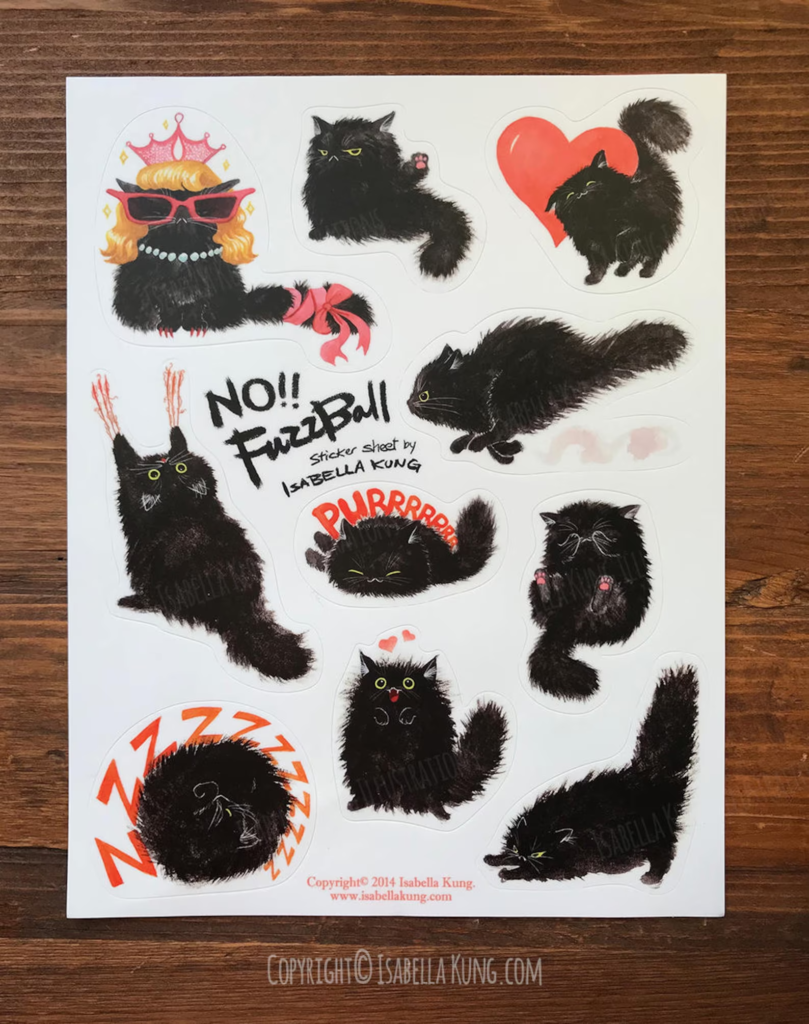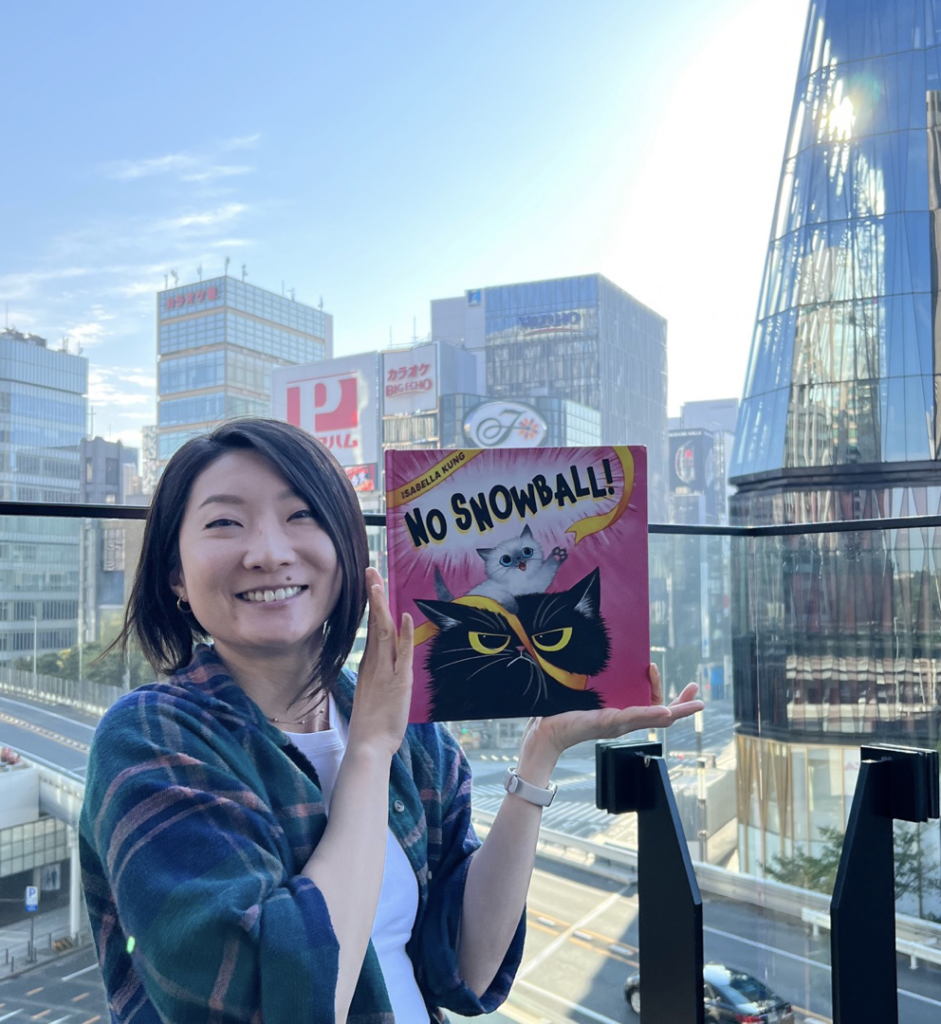Interview by Kristi Wright

Isabella Kung and I met years before her adorable NO FUZZBALL! series found its home in publishing. However our friendship does have its Fuzzball roots. I was such a fan of Kung’s fluffy black cat with attitude–well before she ever found her way into a picture book. I bought oodles of Fuzzball stickers and cards and gave them out as Christmas gifts. Later, Kung and I were regional team members together for our SCBWI region in the California Bay Area. I’m in awe of Kung’s artistic talent and delighted by her kind and generous soul. It’s been a joy watching her become a force in children’s books. – Kristi
KIDLITCRAFT: Soon to be released NO SNOWBALL! is your first author-illustrator sequel! You posted on social media recently about your use of storyboarding to find your way into a story. Did you have the big idea for NO SNOWBALL! before you started storyboarding, or did it take iterations to get there?
Isabella Kung: Yes, I did! Before I started storyboarding, I wrote a couple of rough drafts to just get my ideas on paper. I already knew the concept I wanted to explore and was familiar with my characters and the setting, so it was a bit quicker to get started. I found that it’s best to start experimenting with both sides of the storytelling early, even when you don’t feel quite ready. Storyboards give me a great perspective of the whole story as well as the flexibility to play with every aspect of this book. As you can see from my social media post, I went through multiple iterations of storyboards to nail down the overall story arc, get the rhythm and pacing right, and find the right balance between the text and illustrations.
KLC: You’ve illustrated-only and you’ve been the author-illustrator. How do you tackle one versus the other?
IK: This is a great question! Technically, I approach the illustration side of the storytelling the same way whether I wrote the story or if it’s written by another author. When working on illustrated-only books, the manuscripts are generally very polished and the story arc and concept have been established. I just have to focus on the visual aspects of the book, like figuring out the pagination; character and environmental designs; composition and design; style and mediums choices; and how to narrate the emotionality of a scene…etc. I’m able to tackle illustration-only projects with more direct and formulated methods because someone else has already figured out the story! It’s a collaboration after all and the load definitely feels lighter.
When I am the author-illustrator, the only difference is that I begin the illustration process much sooner than I would when illustrating other authors’ manuscripts. I explore my story ideas and problem-solve with both sides of the narrative until I get it right. I am also more prone to take risks and experiment with new styles or materials when working on my own stories too. It is so wonderful and fulfilling to be able to play with ALL the tools in the toolbox, though it is also vastly more complex, difficult, and time-consuming. While I do think it is great to have the ability to do both, there are so many more choices to consider and figure out on my own before it is even ready to show to my agent. That’s why I enjoy working on my own stories as well as illustrated-only projects!
KLC: How was the process of NO SNOWBALL! different from the NO FUZZBALL! process?
IK: NO FUZZBALL! was my debut author-illustrator picture book. It all started with the character first–Fuzzball was initially designed as a set of emojis, then I figured out her story later when I finally got bit by the writing bug. There were a lot of trial and error, self-doubt, and career detours, but I learned a lot with every mistake and setback. That book took 14 drafts to land a contract and 16 in total before I got the okay to move on to final illustrations.
NO SNOWBALL!’s process on the other hand was so much faster. I only did 7 drafts! Mostly because it is a sequel, much of the character and setting have been established and the foundation has been laid, but I’d like to think I have improved over the years too. Not to mention, NO SNOWBALL! has always been a seedling of an idea while I was submitting NO FUZZBALL! While it took a shorter amount of time, writing this sequel has its own set of challenges as well, mainly figuring out a good balance between introducing a new character to the book and adding new elements (eg. dialogue) to the story, while still staying true to the previously established voice, jokes, rules, and structures set up in the first book. Also, I started NO SNOWBALL! by writing the two main characters’ first interaction with each other and then worked on the character design. It’s funny how the creative process for each book differs, there really is no right or wrong way to start.
KLC: Your characters, Fuzzball and Snowball, are so lovable and well-developed. Do you have any author and/or illustrator tips for creating deeply relatable and charming characters?
Thank you so much! The tip that really worked for me is to start with what you love and know best. For me, that’s cats – I have two napping in my studio as I type this interview! I spend an enormous amount of time observing, playing, cuddling, painting, and obsessing over them. So when it’s time to write or draw a cat character, a lot of their behaviors come naturally to me and my love for them shines through. I draw inspiration from traits that charm me and make me laugh. I’m very lucky that cats are very well-loved around the world, but I think what makes Fuzzball and Snowball so relatable are their motives and desires.
KLC: How do noticing and observation come into your illustration and writing processes? For instance, do you have a sketch journal? a writing journal? Do you do observational studies?
I think in order to capture the essence of a person, an environment, or even an emotion, a creator must observe and try to learn all its nuances. I have multiple sketchbooks for different mediums and situations. Before the pandemic, I used to carry a sketchbook with me wherever I go! Sketching or painting in real life allows me to observe the world around me and forces me to translate those details through my own lens as quickly as possible (due to changing light, weather, and moving subjects). It is also important to note most camera lenses pale in comparison to our natural eyes, and a lot of subtle value or color changes get lost in a picture. Sadly, I have fallen out of this habit in the last two to three years, but it is something I definitely want to rekindle again! I keep a writing journal as well, though I use it to observe the world within me rather than around me. It helps me process emotions and complex internal thoughts, which can sometimes lead to creative inspiration. These practices expand my understanding of the world, myself, and the stories I want to create. They fill my library with resources and give my work the authenticity it needs. I highly recommend everyone to have a sketchbook and/or writing journal practice!
KLC: Your initial publications showcase your deep affinity for illustrating in watercolor. Do you have any other mediums you would like to explore? Which comes first for a project: the medium or the idea?
IK: Yes! So many mediums! Watercolor will always be my favorite, but I also enjoy using ink (painting it with a brush or drawing with fountain pens), gouache, and color pencils. Recently, I started experimenting with water-soluble graphite, ink, and collage for a story I’m working on. There were a few failed attempts but I finally developed a style and method I like that fits the emotional aspect of my story.
For any project, the idea always comes first. I think every story requires an illustrative style that fits its voice, so until a story idea is solidified, I won’t begin to consider the medium. There are rare occasions when the initial inspiration of the story came to me as a vision, that’s when the medium will be considered early on in the process.
KLC: What do you feel you’ve gained from being a part of the children’s book writing/illustrating community?
I’ve gained so much: Knowledge, inspiration, validation, and encouragement just to name a few! Not to mention all the wonderful friendships that I’ve made over the years! Nothing compares to the feeling when you are surrounded by people who understand and celebrate something we all mutually love, especially when our careers tend to be very isolating. The CB writing/illustrating community is so kind, welcoming, and nurturing too. I highly recommend joining SCBWI and perhaps attending a conference or two to connect with others who share the same passions and interests!

KLC: What can Isabella Kung fans look forward to in the future?
I have two more stories for my NO FUZZBALL! Series at different stages. Hopefully, I will get a chance to continue my royal felines’ journey! I have another story on submission about two twin Koalas that I hope can find the right publishing home! I am also working on my very first near-wordless picture book. It is a very emotional and personal story for me, something very different from what I’ve created before. I was trepidatious at first, doubting why I even wanted to work on something so out of my comfort zone. But this idea and vision have been revisiting me again and again for the last four years, so how can I not feel compelled to create it?
Isabella Kung is the author and illustrator of NO FUZZBALL! (Scholastic, 2020), a picture book about a fuzzy feline despot who rules the house with an iron paw. Continuing her feline obsession, she also illustrated over 120 cats for the board books 123 CATS and ABC CATS by Lesléa Newman (Candlewick, 2021).
Growing up in Hong Kong, she would create her own narrative and draw over all her textbooks – anything to make the dull concrete world more colorful! She is delighted she still does both! Her illustrations have received accolades from institutions such as the Society of Illustrators, Spectrum Fantasy Art, 3×3, Creative Quarterly, and SCBWI and her original artwork has been exhibited at galleries in California, Spain, and Singapore.
Outside the world of publishing, Isabella teaches illustration and watercolor classes at Storyteller Academy and Etchr Lab. She is also the current Illustrator coordinator of the SCBWI SF/South region.
Isabella currently resides in San Francisco with her husband and two adorable – you guessed it – cats! She enjoys a good book, dancing, trying all the foods, snorkeling, scuba diving, and traveling!
Isabella is represented by Jennifer Laughran at Andrea Brown Literary Agency.
If you enjoyed our interview with Isabella Kung, you might also enjoy these additional Q&As:
Kristi Wright (co-editor) writes picture books and middle grade novels. Her goal as a writer is to give children a sense of wonder, a hopefulness about humanity, and a belief in their future. She is represented by Kurestin Armada at Root Literary. She is an active volunteer for SCBWI and a 12 X 12 member. Find her at www.kristiwrightauthor.com and on Twitter @KristiWrite.




COMMENTs:
0